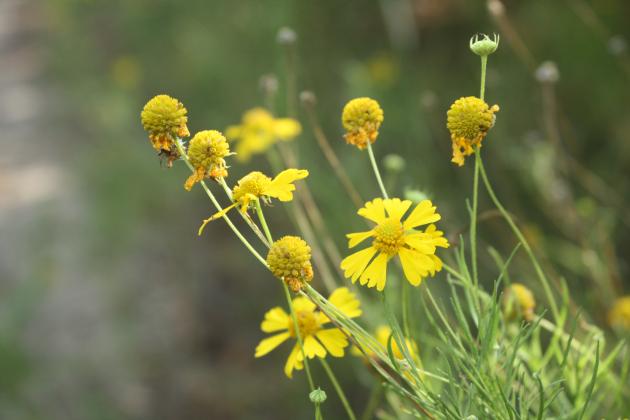Helenium amarum – Snuff.
Fire ants built shelters for aphids and mealybugs
Helenium amarum, sneezeweed or bitter sneezeweed, is a perennial native to the southern U.S., including Texas, and northern Mexico. The plant is usually 10 to 20 inches high but can be taller. It is bushy with several branches so it can be as wide as 3 feet. The narrow leaves are alternate and attach directly to the stem with no petiole. H. amarum has about 8 yellow ray petals that surround a globe-like disk-shaped flower in the center at the top of the stem. The ray petals each have 3 lobes, usually pointing downward, and are spaced further apart than the petals of most flowers. The densely packed center flowers are either a deeper shade of yellow, orange-ish, redish, and sometimes almost brown.
Most sources say the genus Helenium gets its name from Helen of Troy. There is a legend that the flowers sprang from the ground where her tears fell, but I couldn’t find any source that had the story of why Helen was crying. I think amarum means bitter but I’m not sure.
A traditional use was to dry and powder the leaves as snuff. It was sniffed to clear the sinuses by sneezing. The superstitious reason was to clean the body of evil spirits. The medical reason was to clear sinuses to loosen up a head cold. Native Americans used sneezeweed roots and stem to treat fever, the common cold, etc. It is being studied for its anti-inflammatory effects.
The plant is also called bitterweed because it has a bitter taste and strong odor. Some people may experience contact dermatitis handling it. Eating sneezeweed will cause serious gastric upset for most mammals including humans. H. amarum is in the Food and Drug Administration Poisonous Plant Database at fda.gov. The nectar attracts bees and butterflies. Sneezeweed and others in the Helenium genus are used as food plants by the larvae of some butterflies and moths.
Honeydew is a sugar-rich sticky liquid secreted by insects such as aphids and mealy bugs as they feed on sneezeweed and other plant sap. Fire ants, Solenopsis spp., eat honeydew and protect the insects that create it by creating shelters around them. Ants tend them to obtain the honeydew the way we tend cows for their milk. Look closely at a sneezeweed stem and you may see an oblong fire ant-constructed insect shelter, usually made of mud.
It’s thought that sneeze-weed isn’t in more gardens because its common name makes people nervous. It blooms at the same time as many allergy plants such as ragweed that has inconspicuous flowers. So, when people with allergies are sneezing and suffering, they see a flashy plant called sneeze-weed and blame it. It got a bum rap. Allergy plants such as ragweed have small pollen grains that ride on the wind into your nose and eyes. Sneezeweed’s pollen is too large and heavy to be windblown to the height of your head so is not responsible for your allergies. Its pollen is carried by insects.


